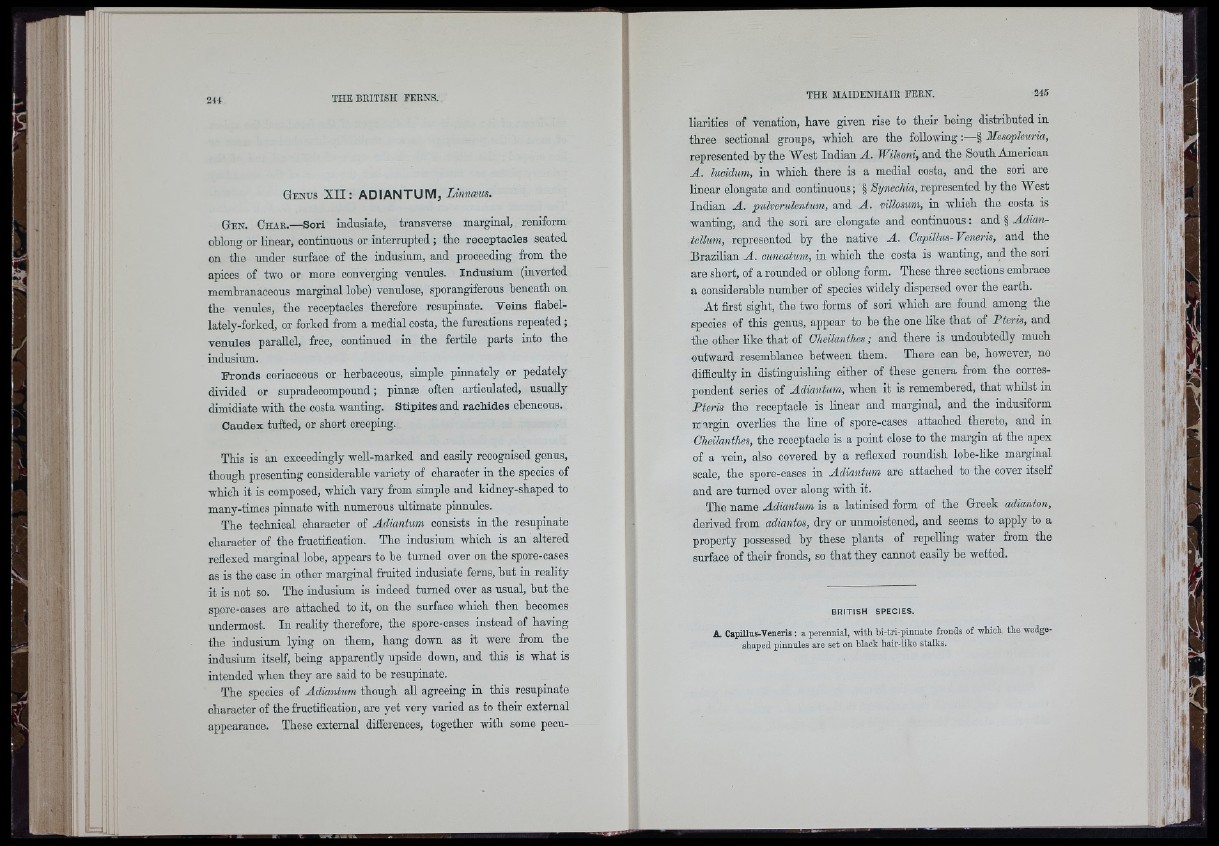
Genus X I I : ADIANTUM, Unnaius.
Gen. Char.—Sori indusiate, transverse marginal, reniform
oblong or linear, continuous or interrupted ; tbe receptacles seated
on the under surface of the indusium, and prooeediug from the
apices of tvro or more converging venules. Indusium (inverted
membranaceous marginal lobe) venulose, sporangiferous beneath on
the venules, the receptacles therefore resupinate. Veins flahel-
lately-forked, or forked from a medial oosta, the furcations repeated ;
venules parallel, free, continued in the fertile parts into the
indusium.
Fronds coriaceous or herbaceous, simple pinnately or pedately
divided or supradeoompound ; pinnæ often articulated, usually
dimidiate with the costa wanting. Stipites and rachides ebeneous.
Caudex tufted, or short creeping.
This is an exceedingly weU-marked and easily recognised genus,
though presenting considerable variety of character in the species of
which it is composed, which vary from simple and kidney-shaped to
many-times pinnate with numerous ultimate pinnules.
The technical character of Adiantum consists in the resupinate
character of the fruotifioation. The indusium which is an altered
reflexed marginal lobe, appears to he turned over on the spore-cases
as is the case in other marginal fruited indusiate ferns, hut in reality
it is not so. The indusium is indeed turned over as usual, but the
spore-cases are attached to it, on the surface which then becomes
undermost. In reality therefore, the spore-cases instead of having
the indusium lying on them, hang down as it were from the
indusium itself, heing apparently upside down, and this is what is
intended when they are said to he resupinate.
The species of Adiantum though all agreeing in this resupinate
character of the fructification, are yet very varied as to their external
appearance. These external differences, together with some peculiarities
of venation, have given rise to their heing distributed in
three sectional groups, which are the following :—§ Mesopleuria,
represented by the West Indian A. Wilsoni, and the South American
A. lucidum, in which there is a medial oosta, and the sori are
linear elongate and continuous; § Synechia, represented by the West
Indian A . pulverulcntum, and A. villosum, in which the costa is
wanting, and the sori are elongate and continuous: and | Adian-
tellum, represented by the native A. Capillus-Veneris, and the
BraziKan A. cuneatum, in which the costa is wanting, and the sori
are short, of a rounded or ohlong form. These three sections embrace
a considerable number of species widely dispersed over the earth.
At first sight, the two forms of sori which are found among the
species of this genus, appear to be the one like that of Pteris, and
the other like that of Cheilanthes; and there is undoubtedly much
outward resemblance between them. There can be, however, no
difficulty in distinguishing either of these genera from the correspondent
series of Adiantum, when it is remembered, that whilst in
Pteris the receptacle is Knear aud marginal, and the indusiform
irargin overlies the Kue of spore-cases attached thereto, and in
Cheilanthes, the receptacle is a point close to the margin at the apex
of a vein, also covered by a reflexed roundish lobe-Kke marginal
scale, the spore-cases in Adiantum are attached to the cover itself
and are turned over along with it.
The name Adiantum is a latinised form of the Greek adianton,
derived from adiantos, dry or unmoistened, and seems to apply to a
property possessed by these plants of repeUing water from the
surface of their fronds, so that they cannot easKy be wetted.
BRITISH SPECIES.
A. Capillus-Venens; a perennial, witE bi-tri-pinnate fronds of wbich tb e wedge-
shaped pinnules are set on black hair-like stalks.
i:
'ni
k.:
t'!i
I-It i
" f
I
■w]
.!!*
I fi